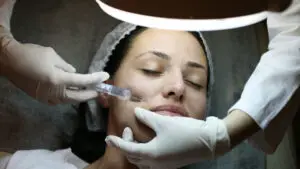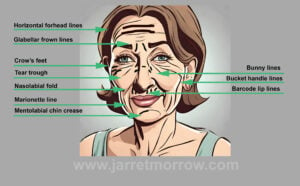As a cosmetic physician, when patients come to see me for a consultation—either at my clinic in Langford or in Duncan—they often arrive with a very specific concern in mind: lip fillers, under-eye fillers, a crease that’s deepening, or a particular wrinkle they’d like softened. This is completely understandable. We tend to fixate on the one feature that bothers us most.
But one of the first things I do is take a big-picture view of the entire face. I look for early signs of volume loss, shifts in facial shape, and how all the features work together in harmony. For example, almost no one walks in saying, “My temples look hollow.” Instead, they say their brows feel heavy, their eyes look tired, or their face looks like it needs lifting. In reality, temple hollowing can create or exaggerate all of those concerns—yet because it’s subtle, most people never notice it directly.
Most people assume aging is just a skin problem: wrinkles, fine lines, pigmentation, sun damage. But high-quality research shows that the biggest changes actually happen much deeper, in the support structures beneath the skin. A review article called “The Facial Aging Process From the ‘Inside Out’” (Swift et al., 2021) illustrates this beautifully, and I want to explain it in clear, approachable terms.
Understanding how your face ages is incredibly important when you’re considering cosmetic treatments. It helps you make informed decisions, sets realistic expectations, and ensures we address the true causes of aging—not just the symptoms you see on the surface. Here’s a paper published by Dr. Arthur Swift, a Canadian plastic surgeon who’s a pioneer in the field of facial injectables. I’ve met Dr. Swift in person at talks at the South Beach Symposium in Miami along with Dr. Susan Winkle, an American dermatologist.
Source: https://pmc.ncbi.nlm.nih.gov/articles/PMC8438644/
Aging Starts Deeper Than You Think
Skin does age, yes—but the deeper layers (fat pads, ligaments, and even bone) change even more dramatically over time. Think of the face like a building: the bones are the foundation, the ligaments are the support beams, the fat pads are the insulation, and the skin is the exterior paint. If the foundation or support beams shift, the exterior will show it.
Bone Loss Is a Major Cause of Facial Aging
Let’s talk a bit more about bone loss. Many people believe their lips simply get thinner and wider with age. While this appears true on the surface, much of the change actually comes from bone loss around the mouth. As the midface bone recedes, the lips collapse inward. This makes them look flatter, thinner, and wider—even if the lips themselves haven’t changed much. For this reason, when someone in their 40s or 50s wants lip filler, it’s often just as important to consider structural support around the mouth as it is to treat the lips directly.
Supporting bone health is important for your overall well-being—and yes, it can influence facial aging. A healthy diet, resistance training, optimizing hormones (including considering HRT when appropriate), not smoking, and avoiding excessive alcohol all help maintain bone density.
Fat Pads Shrink, Shift, and Separate
Next, the fat pads. Facial fat isn’t one big layer; it’s a series of compartments. As we age, some compartments shrink, some descend, and others separate as ligaments weaken. This results in hollow temples, flatter cheeks, deeper nasolabial folds, and the beginning of jowls. It’s not really “weight loss”—it’s redistribution. Imagine your face as a collection of small balloons. Over the years, some of those balloons slowly deflate while others shift downward, changing the overall shape and contour of the face.
Ligaments Loosen Over Time
Ligament changes also play a major role. Facial ligaments act like tiny anchor points that keep everything in place. As they stretch with age, the face loses its natural lift. This contributes to sagging and deeper folds. This is one of the reasons fillers and tightening treatments are effective—they help replace or reinforce support where the ligaments have weakened. Gravity becomes more noticeable as these support structures loosen.
Skin Aging Accelerates when Bone Loss Occurs
Skin aging is real—collagen loss, thinning, laxity, and sun damage all play a role. But many skin changes are amplified by deeper structural changes. When bone and fat diminish and ligaments loosen, the skin drapes over a weakened foundation. That’s why treating the skin alone can only achieve so much. Restoring deeper support often creates more natural, longer-lasting improvement.
What This Means for Treatment
So what does all this mean for treatment? Understanding “inside-out” aging helps guide more effective, natural-looking results. Fillers can restore lost volume and lift. Biostimulators like Sculptra help rebuild deeper collagen support. And skin treatments—from lasers to medical-grade skincare—become even more impactful once the underlying structure is supported. Every person ages differently, so a bespoke plan is essential.
The Bottom Line
The bottom line is simple: aging isn’t just wrinkles that you can iron away with Botox. It’s a three-dimensional process that begins deep below the surface. The best cosmetic results come from addressing each layer of the face—not just the skin. If you’ve been noticing changes you can’t quite explain, this inside-out model helps make sense of them.
If you’d like to explore what’s happening in your own facial structure and learn about personalized treatment options, you’re welcome to book a consultation with me in Langford (Beam Beauty & Wellness Centre) or Duncan (Dermapure Cowichan).
Source:
- Swift A, Liew S, Weinkle S, Garcia JK, Silberberg MB. The Facial Aging Process From the “Inside Out”. Aesthet Surg J. 2021 Sep 14;41(10):1107-1119. doi: 10.1093/asj/sjaa339. PMID: 33325497; PMCID: PMC8438644.





